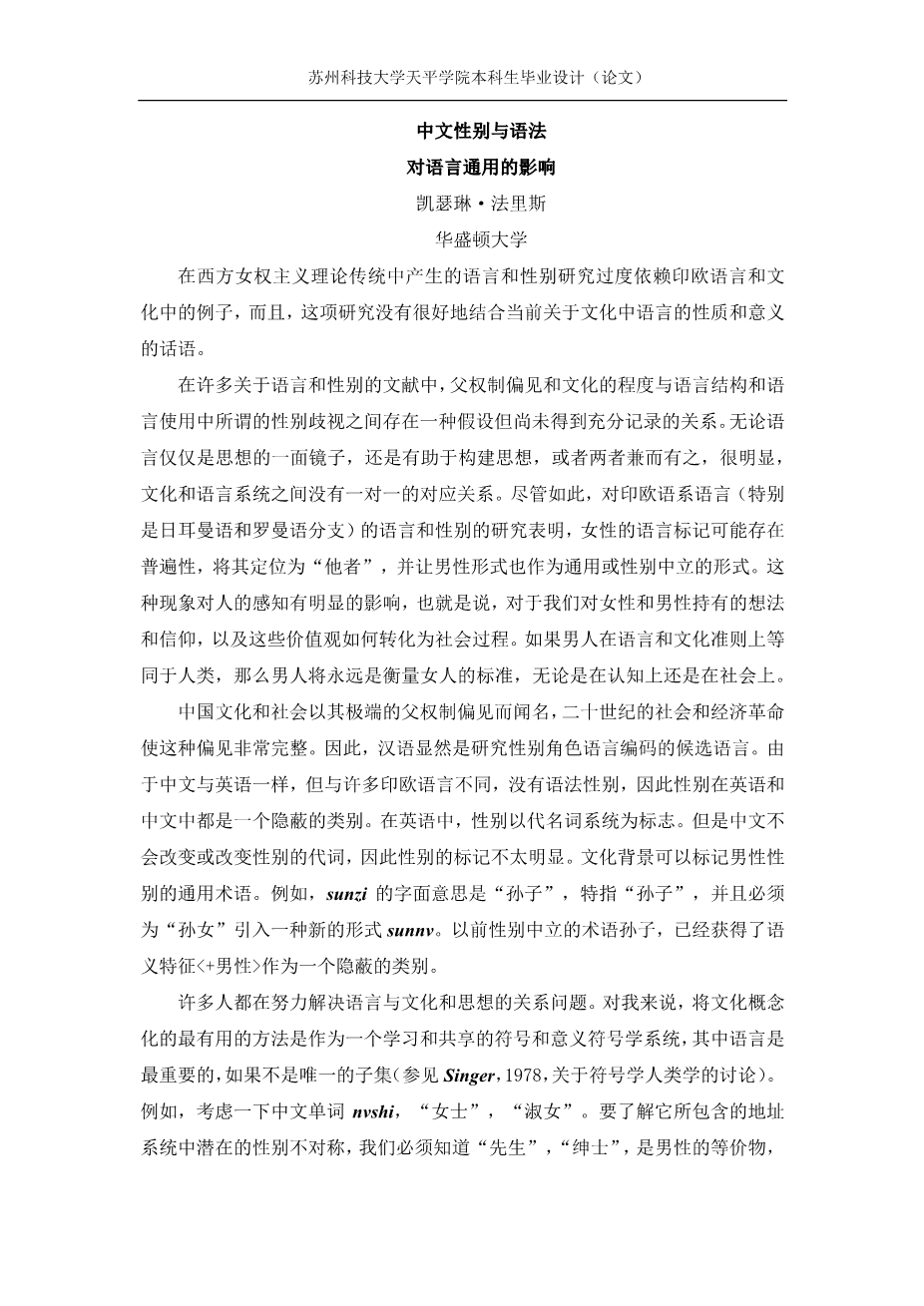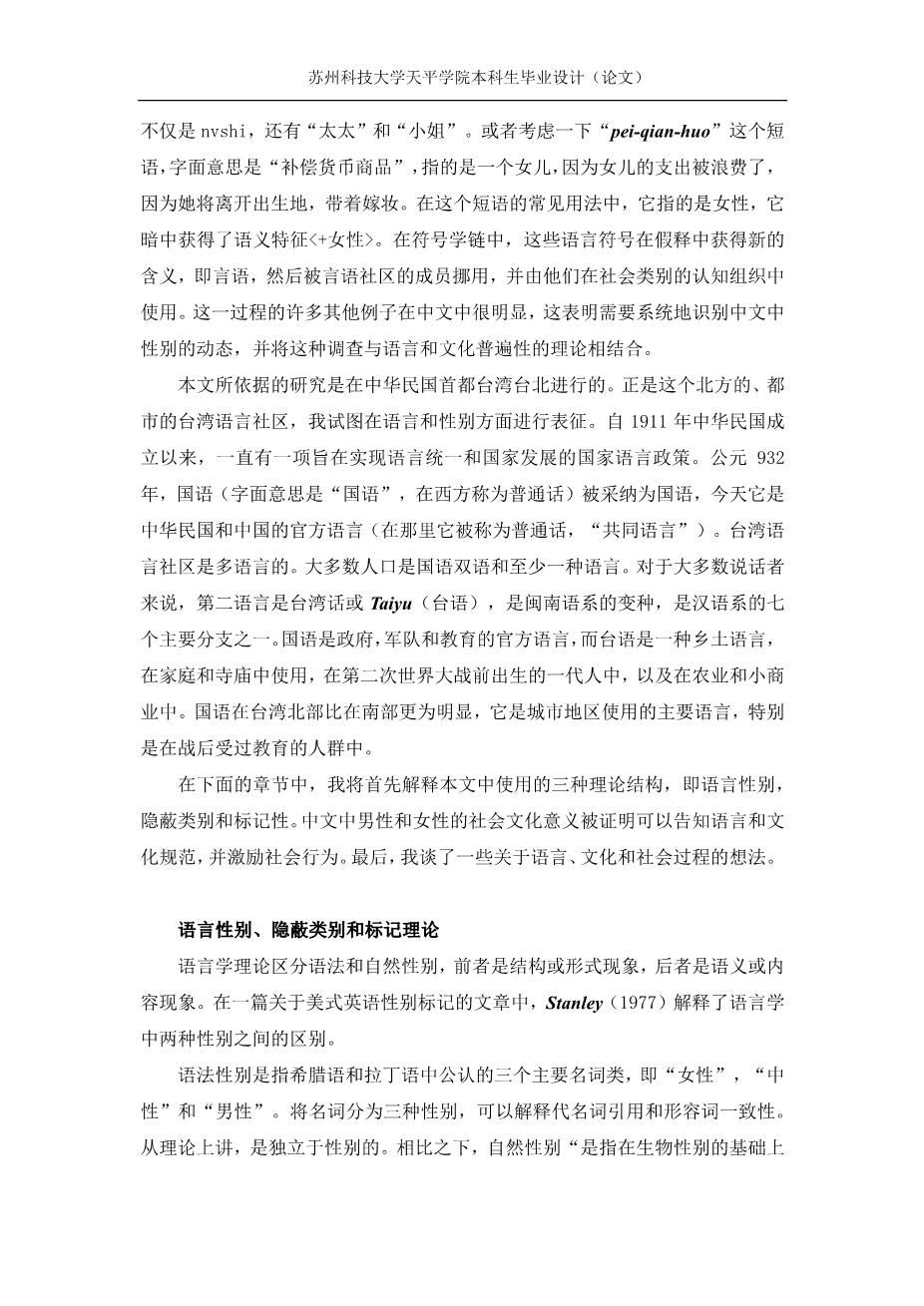Gender and Grammar in Chinese
With Implications for Language Universals
CATHERINE S. FARRIS
University of Washington
The significance of the encoding of sex and gender for questions about the relationship between language and culture, and between language and thought, is just beginning to be explored systematically.1 Language and gender research, arising within the tradition of Western feminist theory, has over relied on examples from Indo-European languages and cultures and has, moreover, not integrated this research very well with the current discourse on the nature and mean of language in culture and society.
In much of the literature on language and gender there is an assumed but not well documented relation between the extent of patriarchal bias ma culture and what has become known as sexism in language structure and language use. Whether language is merely a mirror of thought or helps structure thought, or both, it is clear that there is no one-to-one correspondence between cultural and linguistic systems. Nonetheless, research on language and gender in Indo-European languages (specifically, the Germanic and Romance branches) suggests possible universals in the linguistic marking of the feminine, setting it off as Other, and letting the masculine form serve also as the generic or sex neutral one. This phenomenon has obvious implications for person perception, that is, for the ideas and beliefs we hold about women and men, and how these values get transformed into social process. If Man equals human in the linguistic and cultural codes, then Man will always be the standard against which Woman is measured, both cognitively and socially.
Chinese culture and society are well known for its extreme patriarchal bias, which twentieth century social and economic revolutions have left remarkably intact. Thus, the Chinese language is an obvious candidate for an examination of the linguistic encoding of sex roles. Since Chinese, like English but unlike many Indoshy; European languages, does not have grammatical gender, gender is a covert category in both English and Chinese. In English, gender is marked by the pronominal system. But Chinese does not inflect or vary pronouns for gender, so the marking of gender is less obvious. Cultural context can mark a generic term for the masculine gender. For example, sunzi literally meaning 'grandchild,' comes to mean specifically 'grandson,' and a new form sunnv must be introduced for 'granddaughter.” The previously sex-neutral term, sunzi, has acquired the semantic featurelt; masculinegt; as a covert category.
Many people have wrestled with the problem of how language is related to culture and to thought. For me, the most useful way to conceptualize culture is as a learned and shared semiotic system of signs and meanings, of which language is the most significant, if not unique, subset (see Singer, 1978, for a discussion of a semiotic anthropology). Consider, for example, the Chinese word nvshi, 'lady,' 'gentleshy; woman.' To understand the underlying gender asymmetries in the address system of which it is a part, we must know that xianshen, 'sir, “gentleman,' is the masculine equivalent, not just of nu-sh1, but also of taitai, 'Mrs.,' and xiaojie, 'Miss.' Or consider the phrase pei-qian-huo, literally, a 'compensate-money-commodity,' referring to a daughter, for whom expenditures are wasted, as she will leave the natal home, taking a dowry with her. It is in the common usage of this phrase to refer to women that it covertly acshy; quires the semantic featurelt; femininegt;. In a semiotic chain, these linguistic signs acquire new meanings in parole, that is, speech, which are then appropriated by members of the speech community and used by them in the cognitive organization of social categories. Many other examples of this process are evident in the Chinese language, which points to the need to identify systematically the dynamics of gender in Chinese and to integrate that investigation with theories of linguistic and cultural universals.
The research upon which this article is based was conducted in Taipei, Taiwan, the capital city of the Republic of China (ROC). It is this northern, urban Taiwanese speech community that I seek to characterize with respect to language and gender. Since the establishment of the ROC in 1911, there has been a national language policy aimed at linguistic unification and national development. In I 932, Guoyu (literally the 'national language,' known in the West as Mandarin) was adopted as the national language, and today it is the official language of both the ROC and the PRC (where it is known as Putonghua, the 'common language'). The Taiwanese speech community is multilingual. The majority of the population is bilingual in Guoyu and at least one other language. For the majority of speakers, that second language is Taiwanese or Taiyu, a variety of southern Min, one of the seven major branches of the Chinese language family. Guoyu is the official language of government, the military, and education, while Taiyu, a vernacular language, is spoken in the home and temple, among the generation born before World War II, and in agriculture and petty commerce. Guoyu is much more evident in northern than in southern Taiwan, where it is the primary language used in urban areas, especially among people educated after the war.
In the sections below, I will first explain the three theoretical constructs utilized in the article, namely, linguistic gender, covert categories, and markedness. Sociocultural meanings of male and female in Chinese are shown to inform the linguistic and cultural codes, and motivate social behavior. I conclude with some thoughts on language, culture, and social process.
LINGUISTIC GENDER, COVERT CATEGORIES, AND THE THEORY OF MARKING
Linguistic theory distinguishes between grammatical and natural gend
剩余内容已隐藏,支付完成后下载完整资料


英语译文共 11 页,剩余内容已隐藏,支付完成后下载完整资料
资料编号:[602727],资料为PDF文档或Word文档,PDF文档可免费转换为Word


